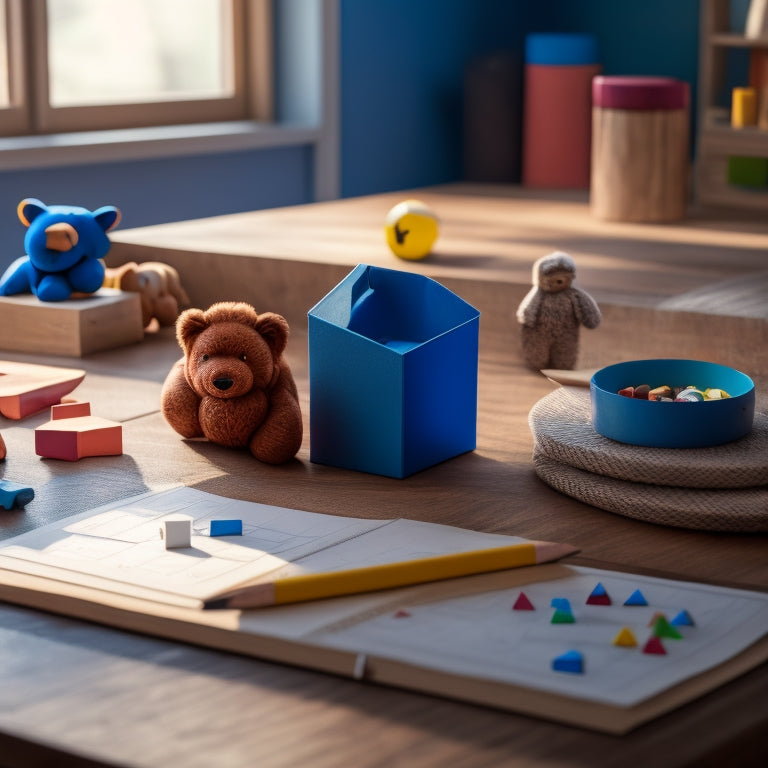
Wooden Manipulatives: Unlocking Math Mastery for Students
Share
You use wooden manipulatives to reveal abstract math concepts into hands-on, interactive experiences that help you build a deeper understanding of mathematical operations and relationships. These tangible tools come in various shapes, sizes, and colors, representing specific numbers for visual learning. You'll practice addition by combining blocks, subtraction by removing them, and develop spatial reasoning through geometric shapes and patterns. By manipulating these blocks, you'll internalize mathematical operations, making complex concepts more accessible and understandable. As you explore wooden manipulatives further, you'll discover even more ways to master math concepts and reveal a deeper understanding of the subject.
Key Takeaways
• Wooden manipulatives provide a hands-on approach to learning math, making abstract concepts more tangible and accessible for students.
• Manipulatives help students develop spatial reasoning, critical thinking, and problem-solving skills through interactive geometry and pattern recognition activities.
• By using manipulatives, students can visualize and internalize mathematical operations like addition, subtraction, multiplication, and division, leading to better understanding and retention.
• Manipulatives cater to different learning styles, allowing students to learn at their own pace and engage with math concepts in a more enjoyable and interactive way.
• Through manipulatives, students can build a strong foundation in math, developing confidence and fluency that translates to future academic success.
Building Blocks of Math
You start building a strong foundation in math by using wooden manipulatives, which transform complex concepts into tangible, interactive experiences. These counting blocks, made of wood in various shapes, sizes, and colors, represent specific numbers, enabling visual learning and hands-on practice.
By combining blocks, you practice addition, seeing the total grow, and by removing them, you understand subtraction, witnessing the quantity decrease. This concrete representation of abstract concepts helps you develop a deeper understanding of basic math skills.
As you engage in hands-on activities, you internalize the concepts, building a solid foundation for future math mastery. With wooden manipulatives, you're not just learning math - you're living it.
Shape, Space, and Patterns
Wooden manipulatives elevate math exploration to the next level by introducing geometry and pattern recognition. This allows learners to build, create, and visualize complex concepts in a hands-on, interactive environment. You'll develop your spatial reasoning by manipulating geometric shapes, such as triangles, quadrilaterals, and pentagons, to understand properties like congruence, similarity, and symmetry.
Pattern blocks will challenge your critical thinking skills as you create shapes and designs to recognize and predict patterns. By experimenting with different blocks, you'll enhance your ability to identify similarities and differences, ultimately strengthening your pattern recognition skills.
With wooden manipulatives, you'll gain a deeper understanding of shape, space, and patterns, preparing you for more advanced math concepts.
Math Concepts in Action
Manipulatives transform math concepts into tangible, interactive experiences, allowing learners to practice and internalize addition, subtraction, multiplication, and division through hands-on activities.
You're no longer confined to abstract numbers and symbols. With wooden manipulatives, you can visualize and represent mathematical concepts, making them more accessible and understandable.
For instance, you can use counting blocks to practice addition and subtraction, or fraction bars to simplify and compare fractions.
These hands-on learning tools provide a visual representation of complex math concepts, enabling you to grasp and apply them with confidence.
Frequently Asked Questions
Can Wooden Manipulatives Be Used for Students With Special Needs?
You can adapt wooden manipulatives to support students with special needs by incorporating adaptive strategies, such as sensory integration techniques, to create a tailored learning experience that meets their unique needs and learning styles.
How Do I Store and Organize Wooden Manipulatives in the Classroom?
As you conquer the chaos, imagine a serene math sanctuary. You'll tame the tide of wooden manipulatives by designing a classroom layout with labeled stations, utilizing vertical storage, and implementing a color-coded labeling system to guarantee effortless access and retrieval.
Are Wooden Manipulatives Suitable for Kindergarten and Preschool Students?
You'll find that kindergarten and preschool students are perfect for wooden manipulatives, as they cater to their developmental readiness and varied learning styles, allowing them to explore and learn math concepts through hands-on, interactive play.
Can I Create My Own Wooden Manipulatives or Must I Purchase Them?
You can create your own wooden manipulatives, exploring DIY options and material choices, like wood types and finishes, to craft customized tools that fit your teaching style and students' needs.
How Do I Integrate Wooden Manipulatives Into Existing Math Curricula?
You align wooden manipulatives with existing math curricula by identifying key concepts, updating your curriculum to incorporate hands-on learning, and ensuring math alignment to maximize student engagement and mastery.